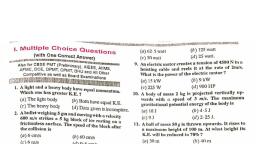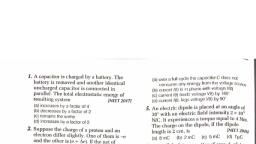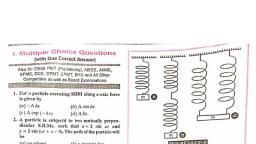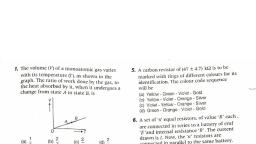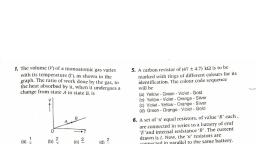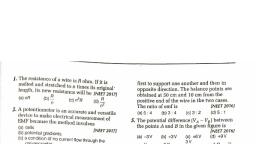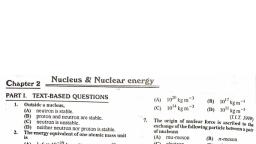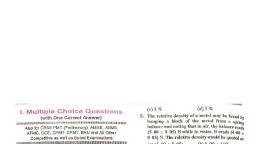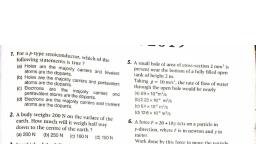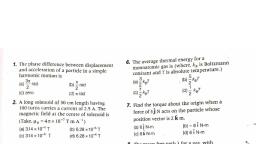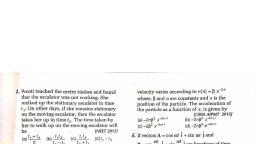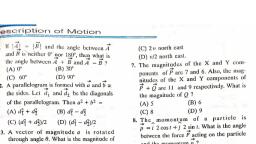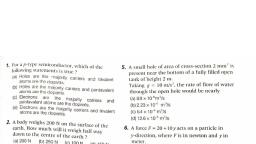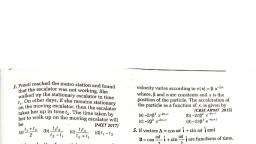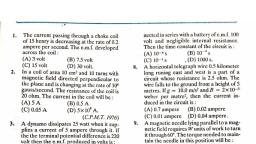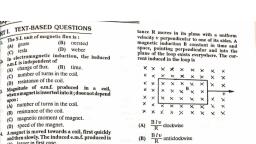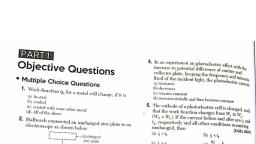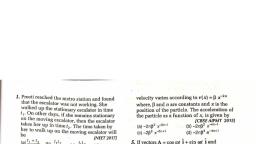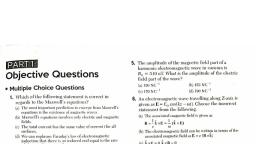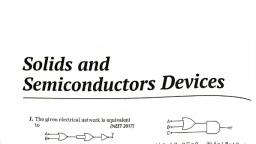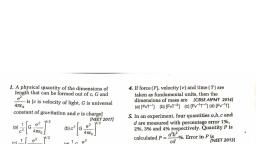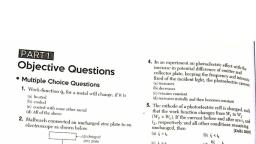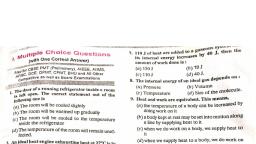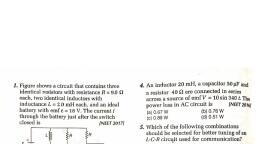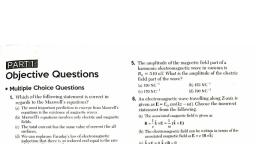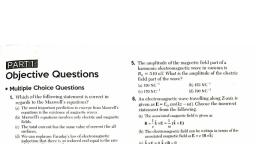Page 1 :
1 The driver of car notice that frequency of hornchanges from 400 Hz to 450 Hz because of, , reflection trom wall. Find car speed(speed of sound = 340 m/s), (A) 10 m/s (B) 20 mis (C) 30 mis (D) 40 mis, , 2. A dimensionless quantity :(A) Never has a unit (B) Always has a unit (C) May have a unit (D) Does not exst, , 3. A soap bubble (ST. 30 dyne/cm) has radius of1 cm. The work done in doubling iis radius, , wouldbe (A) 96 erg (B) 113.5 erg (C) 20 erg (D) 2261 erg, , 4. A spherical black body with a radius of 12 cm radiates 450 watt power at 500 K. If the radius were, halved and the temperature doubled, the power radiated in watt would be, (A} 225 (B) 480 (Cc) 1000 (O} 1800, , _ 7 7 © ratio of wavelengths of the last line of Balmer series and the last line of Lyman series is, ) (8) (cya (0) 0.5, , — Cannat engine having an efficiency 01 vas heat engine, is used as a refrigerator. If the work, ne on the system is 10J, the amount of energy absorbed from the reservoir at lower temperature, MA} 1s {B) 90) (c) 99) (0) 1005, , 7, 4 potentiometer is an accurate and versatile device to make electrical measurements of f.M.F,, because the method involves:, , (A) Cells, , (8) Potential gradients, , (C} A condition of no current flow through the galvanometer, , {D) A combination of cells, galvanometer and resistances, , 8. The acceleration due to gravity at a height 1 km above the earth is the same as at a depth d below, the surface of earth, Then, {A)d 1-2 RM (B)d = lL km (C)d a 2tkm (D)d 2, , 9. The diagrams below show regions of equipotential, , 20M ag ov 40v 10V WY 40v, \\, A i a aA 5 fA, WV” gy, vo wow PD aay, (b), , %, , ¥, fa) (c) (d), , A positive charge is moved from A to B in each diagram., (A) Maximum work is required to move qin figure \c}, (B) In all the four cases the work done is the same, (C) Minimum work is required to move q in figure la}, (D) Maximum work is required to move q in figure \), , wy eV 10
Page 2 :
«A naid ball of mass m strikes a rigid wall at GO~ and gets reflected without toss of, speed as shown in the figure below. The value of impulse imparted by the wal! on, , the ball will be, , , , Amv (B) 2mv (C)Mvi2 (D) Mv/3, , 1, wate Moves from a point (27) aj) to(-lj) 3k) when a force of (i- 3) is, (AY8 J. How much work has been done by the force?, , (B11 (C5 (DY 2, , 12. Th a as . ;, © Potential difference, V1; between the points A and B in the given figure is, , V, 202 3V 14 V., , . 25 Wj, , (A)-3V (BY) ev (C) +6Y" (D) +9, , 5, , 13. A filament bulb (500 W, 100 V) is to be used in a 230 V main supply. When a, resistance R is connected in series, it works perfectly and the bulb consumes 500 W., , The value of R is, (A) 230 Q (B) 46 Q = (C)26 2 (D) 13 Q, , ial di i i d inductance are, 4. otential differences across the resistance, capacitance an nce are, #0 av and 100 V respectively in an L-C-R circuit The power factor of this circuit, , Is, (A)0.4 — (B) 0.5 (C) 0.8 (D) 1.0, , 0% charged, the peak value of the displacement current, fo ', , 15. When the capacitor is 5, , is (A)22A (BY ITA ~ (C44 (D) IY 2K
Page 3 :
16. The distance travelled by a particle, , 17., , 18., , 19., , es = AM AL, , ; : Stary, from rest and moving with an acceleraya’, , s ms~, in the third-second is, 3 ICBSE Alpiy 2004, 10 19, — mM ak, , (a)6m (b) 4m (c), , A particle moving along x-axis has, , acceleration j, al time f, given by, , t, , f=ho (1 a , where f, and T are, , constants. The particle at t = 0 has zero, velocity. In the time interval between { = 0, and the instant when f = 0, the particle's, , velocity (v,) is [CBSE AIPMT 2007}, (a) 47 (0) 3 47° (c) 4? (67, , A car moves from X to Y with a uniform, speed v, and returns to X with a uniform, speed v,. The average speed for this round, , , , trip is [CBSE AIPMT 2007], (244 by) gy (Qe uty, y + y wy ty 2, , The position x of a particle w.r.t. time {, along x-axis is given by x = 9t? -t°, where, xis in metre and ¢ in sec. What will be the, position of this particle when it achieves, maximum speed along the + x direction?, , [CBSE AIPMT 2007], (a) 32m = (b) 54m_— (ce) 81m _— (dd) 24m, , . Two bodies A (of mass 1 kg) and B (of, , mass 3 kg) are dropped from heights of 16 m, and 25 m, respectively. The ratio of the time, taken by them to reach the ground is, , [CBSE AIPMT 2006], (a) -5/4 (b)12/5 (c) 5/12 (d) 4/5
Page 4 :
28. if a car al rest, accelerates uniformly to a, , 21. A particle moves along a straight line OX., speed of 144 km/h in 20s, it covers a, , Ata time ¢ (in second), the distance x (in, , metre) of the particle from O is given by distance of [CBSE AIPMY 1997}, x=404+121-23 {a) 2880 m {b} 1440 m, {c) 400m (d) 20m, , How long would the particle travel before, coming to rest? {CBSE AIPMT 2006] 29, The position x of a particle varies with, , (a) 24m = (b) 40m =e} 56M — 16m time t,as x = at? —bt*. The acceleration of, the particle will be zero at time t equals to, , 22, The displacement x of a particle varies, with time tas x = ae~ % + be™, where a,b, ct [CBSE AIPMT 1997], and § are Positive constants. The velocity (a) zero (b) =, of the particle will {CBSE AIPMT 2005] 2a 2, (a) decrease with time (c) = @s, (b) be independent of a and B 3, (c) drop to zero when a =p 30. If a ball is thrown vertically upwards with a, (d) increase with time velocity of 40 m/s, then velocity of the ball, 23. A man throws balls with the same speed after 2s will be (g = 10 m/s"), vertically upwards one after the other at an [CBSE AIPMT 1996], interval of 2 s. What should be the speed of (a) 15 m/s (b) 20 mis, the throw so that more than two balls are (c} 25 mis (0) 28. mvs, in the sky at any time? (Take g = 9.8 m/s?) 31. Three different objects of masses m,, m,, {CBSE AIPMT 2003] and m, are allowed to fall from rest and, (a) Any speed less than 19.6 m/s from the same point O along three different, (b) Only with speed 19.6 m/s frictionless paths. The speeds of the three, (c) More than 19.6 m/s objects on reaching the ground will be in, (d) At least 9.8 m/s the ratio of [CBSE AIPMT 1995], 24. If a ball is thrown vertically upwards with (a) m sm ims (b) m, :2m, + 3s, speed u, the distance covered during the last (o)4s4s4 (gy tt, t sec of its ascent is [CBSE AIPMT 2003) m M My, 1 1, (a)ut - 5 ot * ()wratt (Cut (A) 2 gt? 32. The water drops fall at regular intervals, . from a tap 5 m above the ground. The third, 25. A stone is thrown vertically upwards. drop is leaving the tap at an instant when, When stone is at a height half of oa th the first drop touches the ground. How far, maximum height, its speed is 10 m/s, then above the ground is the second drop at that, the maximum height attained by the stone instant ? (Take g = 10 m/s?), is(g =10 m/s") [CBSE AIPMT 2001) : ee, (8m = (0) 10m_—(e) 15m_— (a) 20m (a) 125m (b)250m ()3.75m (d)5.00m, , 26. A particle moves along a straight line such 33. Abod' i, , y is thrown vertically upwards from, that its displacement at any time tis given the ground, It reaches a maximum height, , by s=3t* +72? +14t +5.The acceleration of 20m in 5 s. After what time it will reach, of the particle at f= 1sis [ —_ AIPMT — the ground from its maximum height, (a) 18m/s?_ (b) 32m/s?_ (c) 29 mv/s* (d) 24m/s position ? [CBSE AIPMT 1995], , 27. A car moving with a speed of 40 km/h can (aj25s (b)5s (c) 10s = (4) 258, , be stopped after 2 m by applying brakes. If 34, A stone released with zero velocity from, the same car is moving with a speed of 80 the top of a tower, reaches the ground in 4, km/h, what is the minimum stopping s, The height of the tower is (g = 1070/8 ,, distance? [CBSE AIPMT 1998] [CBSE AIPM (a)8m (b) 2m {c)4m {d) 6m {a)20m = (b)40m_— (cy 80. @
Page 5 :
35. A car accelerates from rest at a constant, rate ot for some time, after which it, decelerates at a constant rate B and comes, to rest. If the total time elapsed ist, then, the maximum velocity acquired by the car, , , , , , is {CBSE AIPMT 1994}, fa) (< sh tb) (st), , (a +p) apt }, (c)° “— (d) (: rp, , 36. A particle moves along a straight line such, that its displacement al any time t is given, by s=(t? -60? +3¢+4)m, The velocity when the acceleration is zero,, , is {CBSE AIPMT 1994], (a) ms {b) -12 ms"!, (c) 42ms* (d) -9ms"', , 37. The displacement-time graph of moving, particle is shown below., s, , , Displacernent, o, ™, , Time, , The instantaneous velocity of the particle, , is negative at the point {CBSE AIPMT 1994}, (aD (b) F, (yc (Qe, , 38. A body starts from rest, what is the ratio of, the distance travelled by the body during, , the 4th and 3rd s? ICBSE AIPMT 1993}, Zz 5, , (a) 5 (b} 7, 7 3, , (c) 3 7, , 39. A train of 150m length is going towards, North direction at a speed of 10 m/s, A, parrot flies at the speed of 5 m/s towards, South direction parallel to the railways, track. The time taken by the Parrot to cross, the train is (CBSE AIPMT 1992}, , (a) 12s (bo) 8s ()15s d) 105, , 40. Which of the following curves doeg nol 4, represent motion in one dimension? 1, , (CBSE AIPAET Jog., v Tings, , |, | +, ;, ;, , v, , (a) (b), fs, , ¥ v, , (c) C) (d), (2A, 41. A bus travelling the first one-third distanoe, at a speed of 10 km/h, the next one-third at, 20 km/h and the last one-third at 60 km/h,, The average speed of the bus is ;, {CBSE AIPMT 1991], (a) 9km/h (b) 16 kmh (c) 18 km/h (d) 48 kovh, 42. A car moves a distance of 200 m, It covers, the first-half of the distance at speed, 40 km/h and the second-half of distance at, speed vkm/h . The average speed is, 48 km/h. Find the value of v., [CBSE AIPMT 1997], (a) 56 km/h (b) 60 kery/h (Cc) 50 kerv/h (d) 48 kmh, 43. A body dropped from top of a tower fall, through 40 m during the last two seconds, of its fall. The height of tower is, (g =10 m/s*) [CBSE AIPMT 1991}, {a)60m = (b) 45m — (c) 80m (d) 50m, , 44. A car covers the first-half of the distance, between two places at 40 kin/h and other, half at 60 km/h. The average speed of the, car is [CBSE AIPMT 1990], (a) 40 knvh (b) 48 km/h (c) 50 knv/h (d) GO km/h, , 45, What will be the ratio of the distance moved, by a freely falling body from rest in 4th and, 5th second of journey? [CBSE AIPMT 1989], (4:5 (b)7:9 (0) 16:25 (d)4:1, , 46. A car is moving along a straight road with a, uniform accoleration. It passes through two, points P and Q separated by a distance with, velocity 30 km/h and 40 kin/h respectively., The velocity of the car midway between P, , ————_,;, , , , , , , , and Q is [CBSE AIPMT 1988}, (a) 33.3 km/h (b) 20 V2 kmh, (c) 25 J2 km/h (0) 035 kroyh
